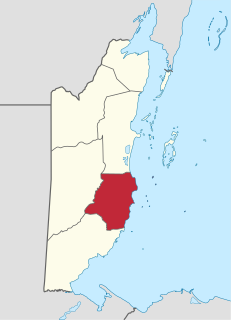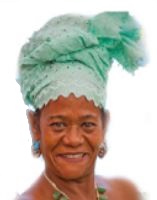
Stann Creek District is a district in the south east region of Belize. According to the 2010 census, the district had a population of 32,166 people. Its capital is the city of Dangriga, formerly known as "Stann Creek Town." Stann comes from "stanns," or safe havens used by colonialists coming from the "old world" to the "new world."
The music of Belize has a mix of Creole, Mestizo, Garìfuna, and Mayan influences. After many centuries of Maya habitation, British colonizers arrived in the area in the 17th century. Belize was Britain's only colony in Spanish-dominated Central America until self-government in 1964 and gaining full Independence in 1981. Belize is still part of the Commonwealth of Nations. Far more influential than this presence, however, was the importation of African slaves.
Garifuna music is a type of music found in Central America, primarily on the Caribbean coast of Belize, Guatemala, Honduras, and Nicaragua.

The Governor-General of Belize is the representative of the monarch of Belize, currently Queen Elizabeth II, in all matters pertaining to the country.

Punta is a dance originated in the Central American coast of Belize, El Salvador Honduras and Guatemala in the late 18th century with African beats.

Danny Michel is a Canadian songwriter & producer.
Belizean Creoles, also known as Kriols, are Creole descendants of Black Africans, enslaved and brought to Belize by English and Scottish log cutters, who were known as the Baymen. Over the years they have also intermarried with Miskito from Nicaragua, Jamaicans and other West Indians, Mestizos and East Indians, who were brought to Belize as indentured laborers. These varied peoples have all mixed to create this ethnic group.
Hunguhungu or fedu is a form of traditional swaying circular dance performed by the women of the Garifuna people of Belize, Honduras, Nicaragua and Guatemala. The music for the dance is composed of rhythmic themes performed by three drummers with alternating call-and-response chanting, and displays a clear African heritage. It is sometimes combined with punta.

The Belizean culture is a mix of influences and people from Kriol, Maya, Garinagu, Mestizo, Mennonites who are of German descent, with a blend of many other cultures from Chinese to Lebanese. It is a unique blend that emerged through the country's long and occasionally violent history.

The monarch of Belize is the head of state of Belize. The incumbent is Queen Elizabeth II, officially called Queen of Belize, who has reigned since 21 September 1981. The heir apparent is Elizabeth's eldest son, Prince Charles, though the Queen is the only member of the royal family with any constitutional role. She, her husband and consort, Prince Philip, Duke of Edinburgh, Prince Charles, and other members of the royal family, including the Queen's other children and cousins, undertake various public ceremonial functions across Belize and on behalf of Belize abroad.

Nohmul is a pre-Columbian Maya archaeological site located on the eastern Yucatán Peninsula, in what is today northern Belize. The name Nohmul may be translated as "great mound" in Yucatec Maya. It is the most important Maya site in northern Belize. The site included a large pyramid, about 17 meters (56 ft) tall, built around 250 BC. Most of the pyramid was destroyed in May 2013 by contractors tearing it apart for rocks and gravel to use to fill roads, leaving only the core of the pyramid behind.
The Lebeha Drumming Center was established in 2002 by Jabbar Lambey and Dorothy Pettersen, in Hopkins, Belize. Hopkins is a small coastal Garifuna community in the Stann Creek District of southern Belize. The center exists with the goals of keeping Garifuna music alive, passing traditional music along to young people in the community, and sharing music with visitors to Hopkins. The center’s focus is on traditional percussion music, though guitars have been donated and are also played.

Law enforcement in Belize is conducted by the Belize Police Department headed by a Commissioner and headquartered in Belize City.
Abortion in Belize is restricted by criminal law, but permitted under certain conditions.

Rosita Baltazar was a Belizean choreographer, dancer, dance instructor and founding assistant director of the Belize National Dance Company. In 2004, she was awarded the Lord Rhaburn Music Award as a dance ambassador and in 2009 she received the Chatoyer Recognition Award from the National Garifuna Council of Belize for her efforts at preserving Garifuna culture.
Belize National Dance Company is a Belizean cultural preservation organization which strives to represent Belize and its many ethnic groups in classical, contemporary and traditional folk dancing.

Leela VernonMBE was a Belizean cultural icon noted for her contributions to preserving Creole culture in the country. She was awarded the title "Queen of Brukdown", received the Order of the British Empire for promoting Creole culture and music, and was named the Brukdown Artist of the Year in 2004. She was honored as National Hero in 2016 by the National Institute of Culture and History.
Sofía Blanco is a Garifuna singer from Guatemala, widely recognized for her talent and efforts to promote the cultural traditions of her people. She has been a featured singer on several albums of Garifuna music, and has toured internationally with the Belizean group Garifuna Collective and Garifuna Women's performance band Umalali, one of the groups selected for performances at the 2010 Winter Olympics in Vancouver.











